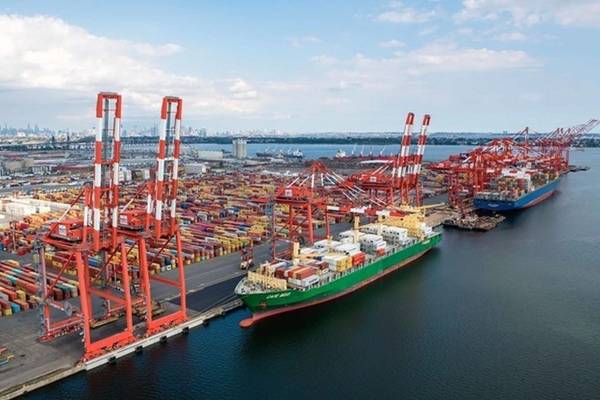Port Authority-Led Supply Chain Panel Steers NY/NJ Seaport
Dec 6, 2024

Ocean carriers, terminal operators, dockworkers, truckers, railroads, warehousers and more all must coordinate to move more than $230 billion in goods in and out of the Port of New York and New Jersey annually.(c) Port of NY / NJ
The summer of 2013 was a breaking point for the Port of New York and New Jersey.
“It was like Armageddon,” said Bethann Rooney, port director at the Port Authority of New York and New Jersey. “It was the worst cargo congestion we’ve ever seen.”
The compounding causes – technological difficulties, a labor shortage, and lingering effects of Hurricane Sandy – couldn’t be fixed by any single entity at the port. It led Rooney, then the manager of port security, to propose something unprecedented for that time: truly linking the supply chain in ways it never had been before.
The idea proved to be a fruitful one: 10 years later, the Council on Port Performance plays a vital role in the Port of New York and New Jersey’s successes, helping it navigate the cargo surge brought on by the pandemic more ably than other large seaports while positioning the port to continue innovating and cooperating to handle expected spikes in cargo growth in the coming decades. The concept proved so productive that the federal government implemented a strikingly similar initiative during the pandemic to help other U.S. ports manage cargo backups.
After that apocalyptic summer in 2013, Rooney came up with the idea over a December weekend when she was tasked by port leadership to generate ideas to avoid sequels to the previous months’ challenges.
“If there is anything good to come of the summer’s meltdown,” Rooney wrote in a white paper introducing the idea, “it is the fact that all of the stakeholders appear to believe that we have real problems and that those problems can only be addressed by a collective effort.”
Days after Rooney submitted the paper, then-Port Director Rick Larrabee approved its creation. The Port Performance Task Force was introduced, with members pledging to cooperate not just in their companies’ best interest, but in the common interest of the port and region. It was co-chaired by Larrabee and John Nardi, the president of the Shipping Association of New York and New Jersey.
“All the port sectors were very siloed, and our goal was to help everyone realize how inextricably linked all of us are,” Rooney said. “If one link starts seeing issues, those issues will be felt up and down the line pretty soon after.”
Over the following six months, the group formulated recommendations to improve cargo flow and customer service at the port. Chief among them was that their conversations should continue.
In August 2014, the first meeting was held of the newly rebranded, newly permanent Council on Port Performance. Today, it consists of 25 members spanning nearly every link in the supply chain and its overseers, including ocean carriers, terminal operators, dockworkers, truckers, warehousers, railroads, the U.S. Coast Guard, U.S. Customs and Border Protection, major retailers and more.
“The idea is to peek around the corner and see issues proactively, rather than reacting to them when it’s too late,” Rooney said.
That proactive peek became crucial as cargo started coming in at unprecedented levels during the pandemic, the result of homebound consumers shopping online for everything from sweatpants to couches to breadmaking machines. On the West Coast, the surge resulted in an apocalyptic sight of their own: hundreds of ships anchored offshore, their goods stranded on those ships as storage space at terminals evaporated.
Meanwhile, things played out differently in the New York/New Jersey region, where council meetings had moved from monthly to weekly.
“We saw this coming because of what we heard in the council,” Rooney said. “We knew storage space was becoming a concern, so we created popup yards to store empty containers, while incentivizing the ocean carriers to get them out of here faster. And it worked.”
As the federal government looked to ease backups at other ports, it announced a similar concept involving disparate supply chain sectors sharing information for the common good. The Freight Logistics Optimization Works (FLOW) initiative was introduced by the Biden administration in March 2022.
A handful of council members have been at the table since the beginning, among them Steve Schulein, the vice president of drayage and industry relations at National Retail Transportation, a supply chain and logistics services provider.
“The council was started with the intent of improving collaboration and cargo flow through the port, and we’ve been incredibly successful in that effort over the last decade,” he said. “There are still challenges ahead, but this forum has shown we can work as a team, in a coordinated effort to keep continually improving our standing as a leading U.S. port.”
The regular meetings have had the added benefit of building a culture of trust at a time when all links in the supply chain will be tested in the very near future, Rooney said, as the increasing demand from population growth and the continued rise of internet commerce will lead to an even busier future for the seaport. The Port Authority expects cargo volumes to double or triple by 2050, and has put plans in place for increased investment at the port that will also rely on port stakeholders to further innovation, investment, and teamwork within each link of the supply chain.
Ports
Government Update
Regulation
infrastructure
Cargo
Green Ports